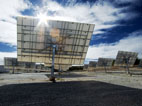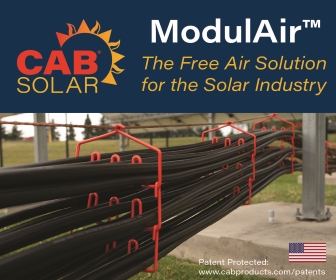Solar PV Systems that Pay Off: Determining the optimal yields
 Photovoltaics (PV) are without doubt the most direct way of taking advantage of solar energy. For best results, however, any incentives or feed-in tariffs available must be considered, as well as the efficiency of the solar energy system used. Not only does the capacity of solar modules have considerable influence on the cost effectiveness of a project, so does the way in which they are used.
Photovoltaics (PV) are without doubt the most direct way of taking advantage of solar energy. For best results, however, any incentives or feed-in tariffs available must be considered, as well as the efficiency of the solar energy system used. Not only does the capacity of solar modules have considerable influence on the cost effectiveness of a project, so does the way in which they are used.
Basically, there are three different technological approaches for PV systems as follows:
1. Rigid systems. Rigid systems originate from the beginnings of PV technology. Today, they can primarily be found on the roofs of private, commercial, or public buildings. But, in solar parks, they are slowly being replaced by tracking systems, which work more efficiently and cost-effectively.
Tracking systems represent a further development of fixed systems. They work according to two different principles:
2. Astronomically guided tracking. Based on astronomical data, the sunrise and sunset times for astronomically guided tracking throughout the year are stored in the software, as is the angle of the sun’s rays. Tracking systems controlled in this way do not take account of weather conditions or other parameters relevant to the energy yield; however, data is provided as a reflection effect through snow, water, or light-colored rock.
3. Intelligent tracking. “Smart” tracking is always oriented on actual conditions by means of light detectors. These systems align the connected solar modules to the brightest, most energetic point in the sky. In this way, reflected light or diffused light that penetrates clouds is also taken into account, which can be referred to as Maximum Light Detection (MLD).
In single-axis systems, solar modules are installed with a fixed angle of elevation dependent on the location. In the southern states of the US, this is usually 20°. In Canada, this is normally around 30°. Tracking takes place only along the horizontal axis, and this is why single-axis systems achieve considerably lower yields than dual-axis systems.
Costs versus benefits
In Germany, the accepted method of approaching the investment and planning for a solar park is to consider the one-off installation costs per kWp. North America is a step ahead: the focus here is on the long-term return of the investment.
If one considers the one-off investment costs alone, rigid systems are the most favorable. Fundamentally, they consist of solar modules, support frames, and inverters. In comparison, tracking systems also require masts, motors, the accompanying moving parts, as well as software, computer power, and an IT network, depending on the technology. By analyzing a typical cost/benefit calculation for a solar park, and including the yield of the different systems in this calculation, the bottom line maintains rigid systems are some 25% more expensive than intelligent tracking systems.
Target yield: 1 GWh per year
Below, the generation of 1 GWh of energy per year is taken as a guideline for a comparative calculation. Since the basic costs for astronomically guided tracking and tracking in accordance with the MLD principle are more or less identical (whereby, the yield from astronomically controlled systems is considerably less), the comparison between rigid systems and dual-axis systems is based on the MLD principle.
The main factor in this calculation is the price of the solar modules used, which affects the overall investment. For this reason, the investment for the assumed yield of 1 GWh per year is calculated on the basis of a Wp price of $2.15, $1.43, and $1.
Results
The investment with a Wp price of $2.15 comes to some $2.18 million for dual-axis tracking systems, and to around $1.83 million for rigid constructions. Therefore, the additional costs for rigid systems lie at around 21% above those for MLD tracking systems.
With a Wp price of $1.43, the investment for dual-axis tracking systems comes to some $1.28 million, and for rigid constructions to around $1.49 million. So, about 16%.
If the Wp price is $1, about $1.14 million must be invested for dual-axis tracking systems, and around $1.29 million for rigid constructions—additional costs: about 13%.
Module prices have only a marginal effect on the cost/benefit analysis. With a module price that is 50% lower (Wp price), the savings potential through dual-axis tracking is reduced by only eight percentage points: from 21% to 13%. It must also be taken into account in this calculation that the payback period for tracking systems is shortened accordingly, which has a favorable effect on the duration and, therefore, the costs of financing.
LCOE value
Numerous parameters must be considered when calculating the Levelized Cost of Electricity (LCOE) value, which is increasingly accepted as an international standard in the solar sector. These parameters not only include total investment costs, but also the annual degradation and annual operation, as well as the ongoing maintenance costs. Inflation, the discount rate, and the service life of a system are also worth mentioning among the multitude of factors.
After the aforementioned calculations, and based on an irradiance of 2,200 kWh typical of California when using one of the largest MLD systems available, an investor will be able to achieve an LCOE value of about 14 cents US per kWh. Until now, only 20 cents was common.
Regional deployment
For this study, the solar radiation values were used for locations in central Europe, southern Europe, and the US. It became obvious that the region of deployment has relatively little influence on the cost/benefit analysis. Another result: with more powerful modules, tracking systems become more profitable.
In conclusion, if one compares costs and yield of rigid PV systems with that of tracking systems, tracking is more profitable, since the additional yield is higher than the additional costs.
Artur Deger is the founder and managing director of DEGERenergie, which has successfully developed MLD technology for solar tracking systems.
DEGERenergie
www.degerenergie.com
Author: Artur Deger
Volume: July/August 2011










.png?r=8747)

